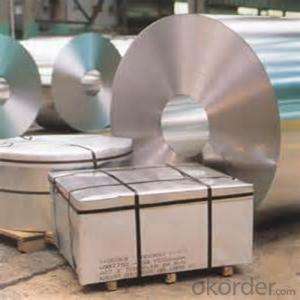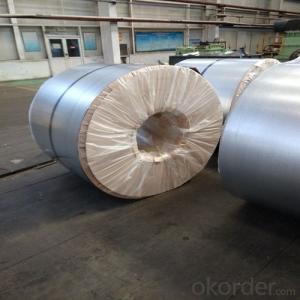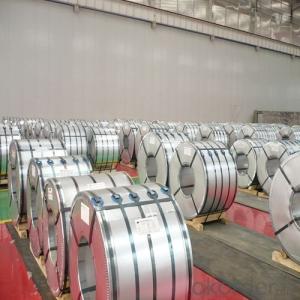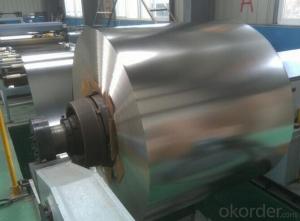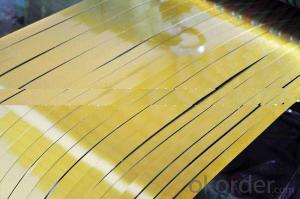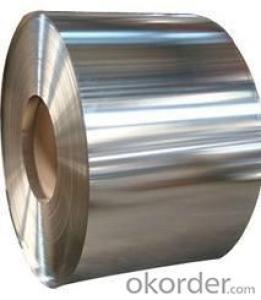Tinplate ETP of High Quality for Metal Containers 0.38 T3BA
- Loading Port:
- Tianjin
- Payment Terms:
- TT OR LC
- Min Order Qty:
- 50 m.t.
- Supply Capability:
- 10000 m.t./month
OKorder Service Pledge
OKorder Financial Service
You Might Also Like
1.Structure of Tinplate ETP of High Quality for Metal Containers 0.38 T3BA Description
Electrolytic Tinplate, is one thin steel sheet with a coating of tin applied by electrolytic deposition. Tinplate made by this process is essentially a sandwich in which the central core is strip steel. This core is cleaned in a pickling solution and then fed through tanks containing electrolyte, where tin is deposited on both sides. As the strip passes between high-frequency electric induction coils, it is heated so that the tin coating melts and flows to form a lustrous coat.
2.Main Features of the Tinplate ETP of High Quality for Metal Containers 0.38 T3BA
Appearance – Tinplate is characterized by its beautiful metallic luster. Products with various kinds of surface roughness are produced by selecting the surface finish of the substrate steel sheet.
Paintability and printability – Tinplates have excellent paintability and printability. Printing is beautifully finished using various lacquers and inks.
Formability and strength – Tinplates have got very good formability and strength. By selecting a proper temper grade, appropriate formability is obtained for different applications as well as the required strength after forming.
Corrosion resistance – Tinplate has got good corrosion resistance. By selecting a proper coating weight, appropriate corrosion resistance is obtained against container contents. Coated items should meet 24 hour 5 % salt spray requirement.
Solderability and weldability – Tinplates can be joined both by soldering or welding. These properties of tinplate are used for making various types of cans.
Hygienic – Tin coating provides good and non toxic barrier properties to protect food products from impurities, bacteria, moisture, light and odours.
Safe – Tinplate being low weight and high strength makes food cans easy to ship and transport.
Eco friendly – Tinplate offers 100 % recyclability.
Tin is not good for low temperature applications since it changes structure and loses adhesion when exposed to temperatures below – 40 deg C.
3.Tinplate ETP of High Quality for Metal Containers 0.38 T3BA Images
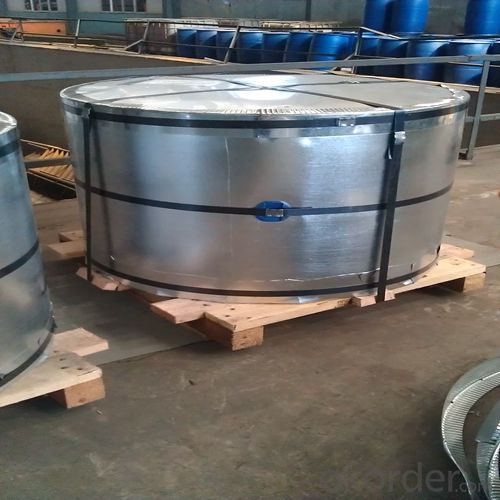
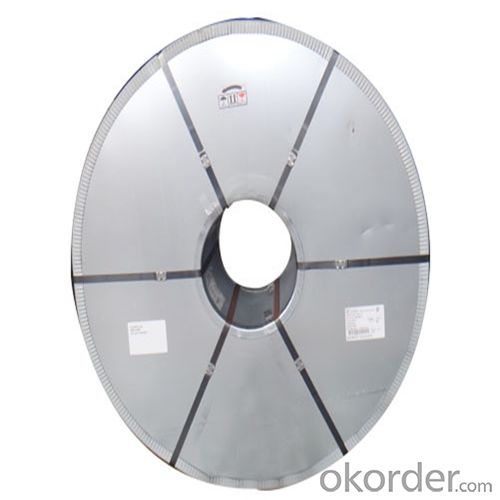
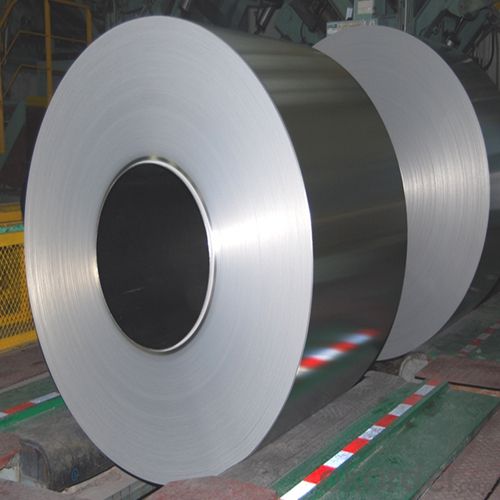
4.Tinplate ETP of High Quality for Metal Containers 0.38 T3BA Specification
Standard: ISO 11949 -1995
Material: MR
Thickness:0.38mm
Width: 600mm -1150mm
Temper: T3
Annealing: BA
Coil Inner Diameter: 508mm
Weight: 6-10 tons/coil 1~1.7 tons/sheets bundle
Passivation:311
Oil: DOS
Surface: Finish
5.FAQ of Tinplate ETP of High Quality for Metal Containers 0.38 T3BA
- How are the tinplates specified?
The tinplates are specified as per the steel base, extent of tempering, the coating weight, annealing method and the surface finish.
- How many types there are for base steels?
The base steels are of three types: Type MR, L, D
- Q:Cookies with tinplate packaging has what advantage?
- The decoration is exquisite: the metal material has good printing performance; the design trademark is bright and beautiful; the packaging container made by it is noticeable, and it is a kind of good sale packing.
- Q:Can tinplate be used for packaging of corrosive substances?
- No, tinplate is not suitable for packaging corrosive substances as it can react with the corrosive materials and lead to contamination or degradation of the product.
- Q:How to prevent the corrosion of tinplate wall hydrogen sulfide blackening, expansion
- Cathodic protectionProtective screen corrosion protection. The principle of protecting the screen is to make the metal of the anode corrode and protect the cathode metal material from corrosion. A metal or alloy (shielding material) connected to the surface of a metal tank and pipeline to be protected shall be protected from corrosion due to the low potential in the primary cell and corrosion of the screen material used as an anode. This method is applicable to the preservation of oil storage tanks, oil tankers and underground oil pipelines. Screen materials are commonly used, including series, aluminum, town and alloy.Cathodic protection of impressed current. Impressed current cathodic protection method is to protect the metal pipelines and oil storage tanks and electrical excavation of the negative link, as a cathode and protected; the power supply of the positive steel scrap corrosion. The method is applicable to underground oil storage tanks, underground pipelines and terminals, pipelines and tankers directly connected with the sea. Generally used anode materials are scrap iron and steel, graphite, high silicon iron, magnetic iron oxide, etc., these materials are consumed, can be replaced at any time.
- Q:How does tinplate contribute to the overall reusability of packaging?
- Tinplate contributes to the overall reusability of packaging by being a highly durable and long-lasting material. Its resistance to corrosion and impact makes it suitable for repeated use, reducing the need for frequent replacement. Additionally, tinplate can be easily cleaned and sterilized, ensuring the safety and hygiene of the packaged goods. This reusability aspect of tinplate packaging helps to minimize waste and promote sustainable practices in the packaging industry.
- Q:How is tinplate affected by exposure to moisture?
- Tinplate is highly susceptible to corrosion when exposed to moisture. The presence of water initiates a chemical reaction that leads to the formation of tin oxide, which causes the tinplate to rust. This can result in the degradation of the material and compromise its structural integrity. Therefore, it is essential to protect tinplate from moisture to ensure its longevity and prevent corrosion.
- Q:Can tinplate packaging be used for household products?
- Yes, tinplate packaging can be used for household products. Tinplate is a durable and versatile material that is commonly used for packaging various products, including household items such as food, beverages, cosmetics, and cleaning supplies. It provides protection against moisture, light, and other external factors, ensuring the quality and longevity of the packaged goods. Additionally, tinplate packaging offers an appealing aesthetic and can be easily recycled, making it a suitable choice for sustainable and eco-friendly packaging solutions.
- Q:Can tinplate be used for promotional or gift packaging?
- Yes, tinplate can be used for promotional or gift packaging. It is a versatile material that offers durability, aesthetic appeal, and the ability to be customized with various designs and finishes. Tinplate packaging can enhance the perceived value of a product or gift, making it an excellent choice for promotional purposes.
- Q:What are the main applications of tinplate in the household goods industry?
- Tinplate is commonly used in the household goods industry for various applications such as food and beverage packaging, storage containers, kitchenware, and decorative items. Its corrosion resistance, durability, and ability to seal in freshness make it an ideal material for cans, jars, and tins. Additionally, its versatility allows for the creation of aesthetically pleasing and functional household items like trays, buckets, and utensils.
- Q:How does tinplate perform in terms of heat transfer?
- Tinplate performs poorly in terms of heat transfer compared to other materials.
- Q:What are the main differences between tinplate and tinplate laminates?
- The main difference between tinplate and tinplate laminates lies in their composition and structure. Tinplate is a steel sheet coated with a thin layer of tin, providing it with corrosion resistance and enhanced durability. On the other hand, tinplate laminates are constructed by bonding tinplate with other materials, such as plastic or paper, for additional functionalities. These laminates offer the combined advantages of tinplate and the secondary material, making them suitable for various packaging applications.
1. Manufacturer Overview |
|
|---|---|
| Location | |
| Year Established | |
| Annual Output Value | |
| Main Markets | |
| Company Certifications | |
2. Manufacturer Certificates |
|
|---|---|
| a) Certification Name | |
| Range | |
| Reference | |
| Validity Period | |
3. Manufacturer Capability |
|
|---|---|
| a)Trade Capacity | |
| Nearest Port | |
| Export Percentage | |
| No.of Employees in Trade Department | |
| Language Spoken: | |
| b)Factory Information | |
| Factory Size: | |
| No. of Production Lines | |
| Contract Manufacturing | |
| Product Price Range | |
Send your message to us
Tinplate ETP of High Quality for Metal Containers 0.38 T3BA
- Loading Port:
- Tianjin
- Payment Terms:
- TT OR LC
- Min Order Qty:
- 50 m.t.
- Supply Capability:
- 10000 m.t./month
OKorder Service Pledge
OKorder Financial Service
Similar products
New products
Hot products
Hot Searches
Related keywords
